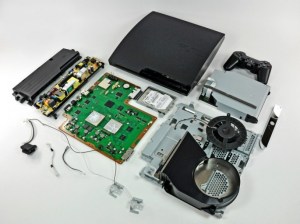You can find the first part of my talk with Ted Price right here: The Playstation and Me: Ted Price, part 1. Continuing the discussion of Price’s history with video games and Playstation, the chief Insomniac speaks on making the most of the PS3 processors, what they learned from Resistance 2 and his love of LittleBigPlanet.
One of the things I’ve heard through various iterations of the Playstation consoles is that they’re notoriously difficult machines to program for, like to manage memory. And I’m asking the people that I’m talking to if that’s a fair assessment. Do you feel like you had some hurdles to jump initially? Or was it easier than people tend to say? I mean, going from PS2 to PS3.
Well. I think easy is one of those slippery words, because game developers have a real need to get the most they can out of whatever hardware they’re using. And the Playstation–no matter which one you’re talking about–have always been called a hardcore engineer’s platform.
If you really like getting down to the metal and low-level programming, you can have machines do amazing things. If you’re coming from a PC background, where you have a lot more memory available and a development environment that’s perhaps a little bit more straightforward, the transition is more difficult. However, for the guys who have joined Insomniac over the years, most of them on our engine team are hardcore engine programmers who love what the Playstation consoles provide in terms of just raw power.
So it’s pretty much like you have to get your hands dirty in order to really maximize what you get out of it?
 Yeah. Probably the best example is the Playstation 3, where it has a complex architecture, and to really take advantage of it, you’ve got to be putting processes on the SPUs. You can’t put everything on the CPU or else your program will not run fast. It’s designed essentially for parallel processing. That’s the whole beauty of the machine. But if you are coming from a different paradigm where you’ve been working on say, just three cores at once, you haven’t dealt with SPUs, it’s sometimes hard for people to wrap their head around.
Yeah. Probably the best example is the Playstation 3, where it has a complex architecture, and to really take advantage of it, you’ve got to be putting processes on the SPUs. You can’t put everything on the CPU or else your program will not run fast. It’s designed essentially for parallel processing. That’s the whole beauty of the machine. But if you are coming from a different paradigm where you’ve been working on say, just three cores at once, you haven’t dealt with SPUs, it’s sometimes hard for people to wrap their head around.
The other thing about Sony has been the way they’ve kind of culturally shifted media consumption at least with the PS2 and the PS3. The PS2 helped the whole DVD format get adopted in homes and Blu-ray in the PS3. Even going to a CD based media on the PS1, I think it changed the way people thought about a game machine. What was that experience like for you? Do you think this is something they intended from the get-go with each machine? Or was it something accidental?
It’s hard for me to comment on the PS1 because Sony wasn’t the first hardware manufacturer to use CDs. But I do think it was the logical choice because CDs can store so much more information than a cartridge and were so much cheaper. It was kind of a no brainer. When the Playstation 2 started using DVDs, I think, yeah, there probably was a lot of thought given to the fact that not only can you fit more data on a DVD for games, you can also take advantage of its movie-playing capabilities.
Because at the time the Playstation 2 came out, DVDs were the newest thing. They provided higher resolution movies, or better movie viewing experiences. And for people who wanted one entertainment system in their living room, the PS2 provided it all. And then the same thing happened with the Playstation 3. It was really, the best and cheapest Blu-ray player on the market. So if you are a videophile and you want to have an amazing movie experience at home, well, really at the time when the Playstation 3 came out, there weren’t any other choices. You bought a Playstation 3. And the additional benefit was that hey, you get to play some great games on it as well if you’re a gamer.

